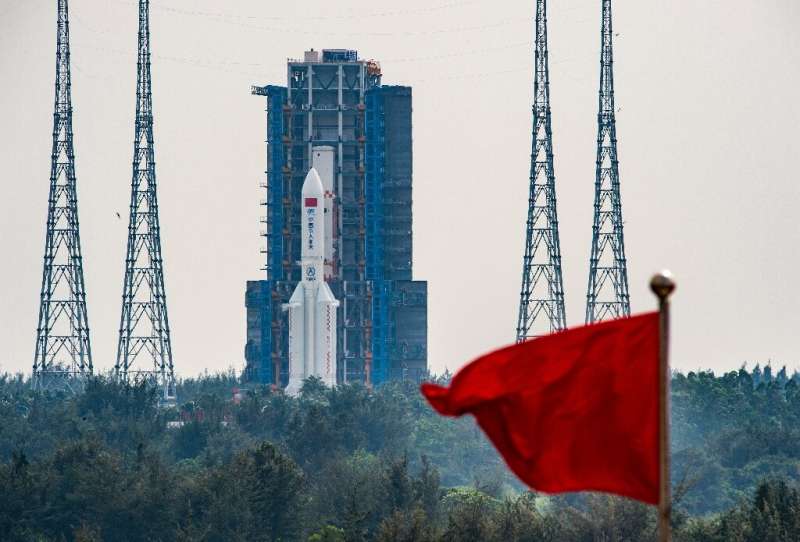
Copernical Team
USSPACECOM Deputy Commander discusses deep space exploration
 U.S. Space Force Lt. Gen. John Shaw, U.S. Space Command deputy commander, participated in the Accelerating Sustainable Deep Space Exploration panel, alongside Mr. Jim Free, NASA Exploration Development Systems Mission Directorate associate administrator at ASCEND's 2022 Conference in Las Vegas, Oct. 24, 2022.
The session aimed to "outline the challenges of deep space, review similar histor
U.S. Space Force Lt. Gen. John Shaw, U.S. Space Command deputy commander, participated in the Accelerating Sustainable Deep Space Exploration panel, alongside Mr. Jim Free, NASA Exploration Development Systems Mission Directorate associate administrator at ASCEND's 2022 Conference in Las Vegas, Oct. 24, 2022.
The session aimed to "outline the challenges of deep space, review similar histor NASA laser project benefits animal researchers, UW scientists show
 Scientists researching forest carnivores such as martens, foxes and coyotes spend hours clambering through rugged terrain, sometimes in deep snow, placing and baiting camera traps to learn about animals' behavior in relation to their habitat.
In recent years, this on-the-ground work has received a big boost from what might seem to be an unlikely source: NASA.
In a new scholarly paper
Scientists researching forest carnivores such as martens, foxes and coyotes spend hours clambering through rugged terrain, sometimes in deep snow, placing and baiting camera traps to learn about animals' behavior in relation to their habitat.
In recent years, this on-the-ground work has received a big boost from what might seem to be an unlikely source: NASA.
In a new scholarly paper Let the Detour Begin - To Gediz Vallis Ridge We Go: Sols 3637-3638
 This is a two sol weekend plan, as Saturday is a soliday. On the first sol, we characterize the workspace in front of us and then drive on the second sol to a new workspace. We are now officially on our detour, a short round trip to image and capture geochemistry of the "Gediz Vallis ridge" up on the pediment, before coming back down to the "Marker Band valley" and rejoining the MSAR (Mount Shar
This is a two sol weekend plan, as Saturday is a soliday. On the first sol, we characterize the workspace in front of us and then drive on the second sol to a new workspace. We are now officially on our detour, a short round trip to image and capture geochemistry of the "Gediz Vallis ridge" up on the pediment, before coming back down to the "Marker Band valley" and rejoining the MSAR (Mount Shar 18 SDS, France's COSMOS integrate SDA knowledge during 'Operator Exchange'
 The 18th Space Defense Squadron (18 SDS) hosted five French space operators from the Operational Center for Military Surveillance of Space Objects (COSMOS) to integrate Space Domain Awareness (SDA) expertise during an 'Operator Exchange' here Oct. 3-6, 2022.
The 4-day event, facilitated by the 18 SDS's Space Situational Awareness Partnership and Coalition Engagement (SPACE) office, aimed t
The 18th Space Defense Squadron (18 SDS) hosted five French space operators from the Operational Center for Military Surveillance of Space Objects (COSMOS) to integrate Space Domain Awareness (SDA) expertise during an 'Operator Exchange' here Oct. 3-6, 2022.
The 4-day event, facilitated by the 18 SDS's Space Situational Awareness Partnership and Coalition Engagement (SPACE) office, aimed t AFWERX AFVentures enhances SBIR/STTR program to increase tech transition
 AFWERX AFVentures began the new fiscal year with multiple enhancements to the Small Business Innovation Research/Small Business Technology Transfer, or SBIR/STTR, Program after Congress reauthorized the program, Sept. 30, 2022. These improvements aim to further encourage domestic small businesses to engage in Air Force and Space Force research and development with potential for commercialization
AFWERX AFVentures began the new fiscal year with multiple enhancements to the Small Business Innovation Research/Small Business Technology Transfer, or SBIR/STTR, Program after Congress reauthorized the program, Sept. 30, 2022. These improvements aim to further encourage domestic small businesses to engage in Air Force and Space Force research and development with potential for commercialization CAPSTONE 2 weeks from lunar arrival
 Advanced Space LLC., a leading space tech solutions company with breakthrough navigation technology, completed its fourth trajectory correction maneuver (TCM) for CAPSTONE on Thursday. TCM-4 was the fourth of six planned maneuvers en route to the Moon, targeting the precise orbit for the CAPSTONE demonstration. This follows the restoration of the spacecraft's capabilities as it has recovered fro
Advanced Space LLC., a leading space tech solutions company with breakthrough navigation technology, completed its fourth trajectory correction maneuver (TCM) for CAPSTONE on Thursday. TCM-4 was the fourth of six planned maneuvers en route to the Moon, targeting the precise orbit for the CAPSTONE demonstration. This follows the restoration of the spacecraft's capabilities as it has recovered fro Largest potentially hazardous asteroid detected in eight years
 Twilight observations with the US Department of Energy-fabricated Dark Energy Camera at Cerro Tololo Inter-American Observatory in Chile, a Program of NSF's NOIRLab, have enabled astronomers to spot three near-Earth asteroids (NEA) hiding in the glare of the Sun. These NEAs are part of an elusive population that lurks inside the orbits of Earth and Venus. One of the asteroids is the largest obje
Twilight observations with the US Department of Energy-fabricated Dark Energy Camera at Cerro Tololo Inter-American Observatory in Chile, a Program of NSF's NOIRLab, have enabled astronomers to spot three near-Earth asteroids (NEA) hiding in the glare of the Sun. These NEAs are part of an elusive population that lurks inside the orbits of Earth and Venus. One of the asteroids is the largest obje Arianespace and Space Machines sign MOU to study last-mile services
 Last week, during the French Space Tour organized by Business France in Australia, Arianespace and Space Machines Company announced the signature of a Memorandum of Understanding (MoU) to define the terms and conditions of possible future cooperation.
Arianespace works on several opportunities with customers looking for direct GEO injection or specific LEO/MEO orbits. In order to provide t
Last week, during the French Space Tour organized by Business France in Australia, Arianespace and Space Machines Company announced the signature of a Memorandum of Understanding (MoU) to define the terms and conditions of possible future cooperation.
Arianespace works on several opportunities with customers looking for direct GEO injection or specific LEO/MEO orbits. In order to provide t Final module docks at China's Tiangong space station

The final module of China's Tiangong space station successfully docked with the core structure on Tuesday, state media said—a key step in its completion by year's end and a landmark moment in the country's space ambitions.
Tiangong is one of the crown jewels in Beijing's well-funded programme—which has landed robotic rovers on Mars and the Moon, and made the country only the third to put humans in orbit—as it looks to catch up with major spacefaring powers like the United States and Russia.
China has been excluded from the International Space Station (ISS) since 2011, when Washington banned NASA from engaging with Beijing.
Tiangong's completion would signal "China is now an equal player in space with the United States, Russia and Europe", analyst Chen Lan told AFP.
"In terms of scientific and commercial aspects, it is always good to see new players coming.... Competition will always speed up innovation," he added.
'Earth is in our hands': Astronaut Pesquet's plea for the planet

From his unique viewpoint hundreds of kilometres above Earth, French astronaut Thomas Pesquet told AFP he felt helpless watching fires rage across the planet below, calling for more to be done to protect this fragile "island of life".
Pesquet said his two tours onboard the International Space Station convinced him more than ever that the world is failing to address the threat posed by climate change.
He also witnessed moments of astonishing beauty while in space, some of which are captured in 300 photos published in his new book "La Terre entre nos mains" (Earth is in our Hands), released this week in France, the profits of which will go to charity.
Pesquet wrote that he initially "caught the photo bug" during his first tour on the ISS in 2016-2017.

